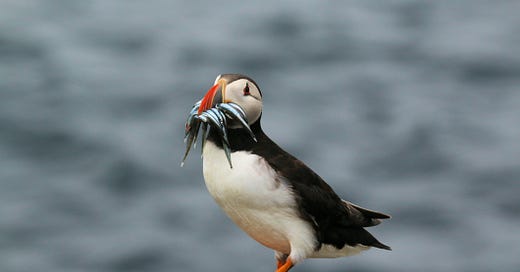The vulnerability of life
Katrina Porteous, the T.S. Eliot prize shortlisted poet, on sandeels and false springs
A flash of silver catches my eye. Ten centimetres long, narrow, straight, a bright tube of tin foil lies on the sand at my feet, at an angle to the tide’s fizzing edge. I bend to peer at it. A pale blue sequin pinned by a deep black dot stares back at me. There is a moment’s frisson: life recognising life. The sequin gazes from a tapered head, a body delicately zigzag-patterned with the faintest oily sheen of pink, lilac, turquoise. The sandeel looks vivid, almost electric, but it does not move. The tide is not coming back for it.
It is one of those ‘midwinter spring’ mornings, when the light feels strong, and as I set off on my walk there’s a tremendous, energetic chatter of starlings on wires and sparrows in hedges. Is it spring yet? Is it? Is it? It’s cold, but out of the keen north wind there’s a perceptible warmth in the sun. We all know the two steps forward, one step back dance of spring. February and March will bring its ‘lambing storms’; snow, rain, gales. But dawn comes earlier and the nights are noticeably lighter now.
From the rocky Point at the head of the bay, the horizon stretches out so far you can see the Earth’s curve. You can feel its turn in the tilt of the light. The sea is a deep, almost sapphire blue, and its slow, gentle roll breaks lazily against the rocks, with a constant low bass roar. Buried in the bent grass and sand, there’s a tiny ruined chapel. Beyond it, just off the Point, a small red boat is hauling its pots, and close to it, a cormorant is fishing. ‘Gormers’, the fishermen used to call them. The bird’s dark prehistoric outline bobs up and vanishes under the waves’ roll. Once, on such a day, this stretch of sea would have been scattered with cobles, the traditional local fishing boat. A hundred years ago, or 500, they would have been catching cod and haddock on longlines. In my youth, they would have worked crab and lobster pots like this boat. In the decades since, due to complicated pressures from widespread industrial fishing and the laws around it, the small-scale sustainable local fishery that once supported villages like mine has contracted to almost nothing.
I sit for a while on the ruined wall. Among last year’s old white grass, with its crackling stalks of dock and dry cow parsley kex, new green clumps of thrift are showing, tender little rosettes that will give rise to chickweed flowers, and the first tiny waxy leaves of scurvy grass, which takes its name from its high ascorbic acid content. In a few months, when the gormers are nesting on the Islands, this chapel will be frothy with its white flowers, as if decorated for a wedding.
I am on my way home when I find the sandeel. It feels significant, like a gift. I have just been reading about the EU’s attempt to overturn the UK ban on sandeel fishing. Sandeels are a vital link in the food chain. They are not eels but small fish, whose earliest fossils date back 55 million years. They are probably what the gormer I saw was hunting, just as its ancestors would have fished for them, millions of years before our ancestors evolved. In spring and summer you can sit here for hours, watching Arctic terns and little terns plummet like stones, in pursuit of them. The aerobatic birds stream overhead with the bright, metallic sandeels glinting in their beaks. Puffins, too – a rare and endangered bird in UK waters – hunt them in summer within sight of this shore. Only last week I watched bottle-nosed dolphins arc and leap from the water off the end of this Point; a sight which, 25 years ago, would have been unthinkable at this time of year. But now the water is warmer. Dolphins also eat sandeels, as do cod and haddock. I have never found any human who eats them here, but sport fishermen use them for bait. And factory ships from distant waters catch them.
In 2021, according to the charity Blue Marine Foundation, 446,765 tonnes of sandeels were hoovered up from the North Sea; around 11 billion of them, mostly by industrial vessels from Denmark, to be processed for pet food, fishmeal for salmon farms, margarine, fertilizer. In March 2024 sandeel fishing was banned in the English North Sea and all Scottish waters after a quarter of a century of campaigning. Here, for once, was a good news story. But two steps forward, one back. Now the EU is trying to undo that ban. It argues that the sandeel fishery is socially and economically important to Denmark, and that fluctuations in the sandeel population are due to ‘natural mortality’. The day I write this, the day that I find the sandeel, the hearing is in its final session. The Court decision is not expected until April.
Something happens to you as you age. The vulnerability of life – all life, in its endlessly intricate interconnections, from the frailest new leaf to the vast oceans – becomes more starkly apparent. I look at that tiny, insignificant strip of silver protein lying at my feet, a spelk from a glittering ocean, and it stares back at me, its eye registering movement, its nervous system sensing mortal danger. Then I pick it up and, for an instant – pure muscle, wild and alive – it wriggles and takes flight as I fling it as far as I can back into the sea.
Katrina Porteous' fourth poetry collection, Rhizodont, was published by Bloodaxe Books in June 2024 and was shortlisted for the T.S. Eliot prize




